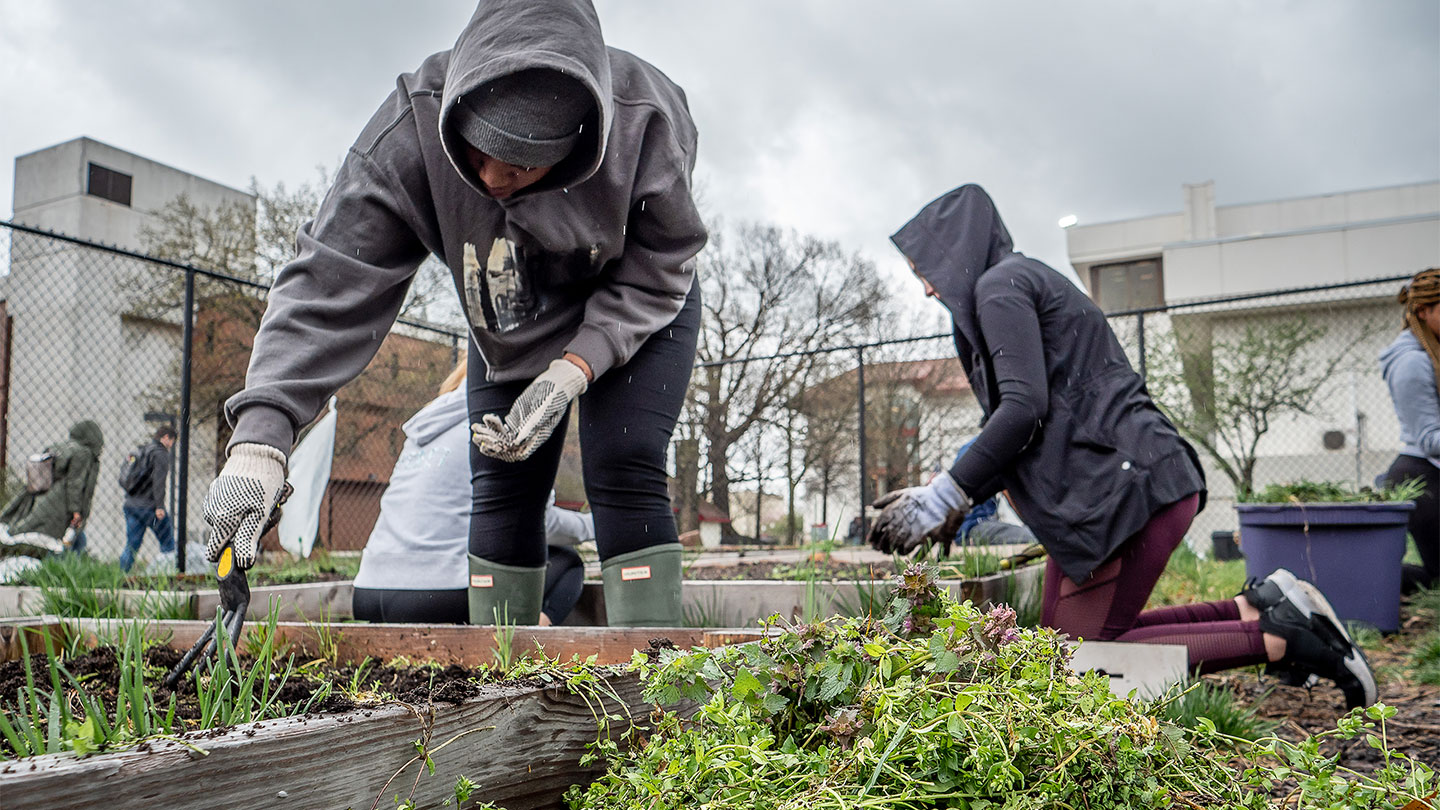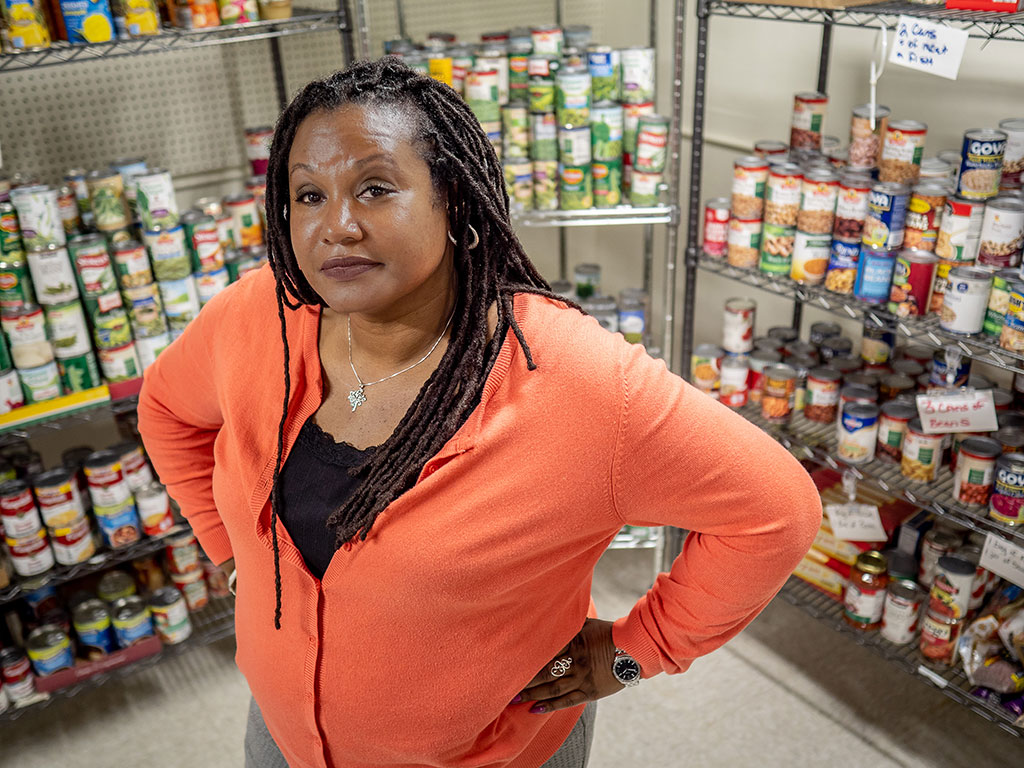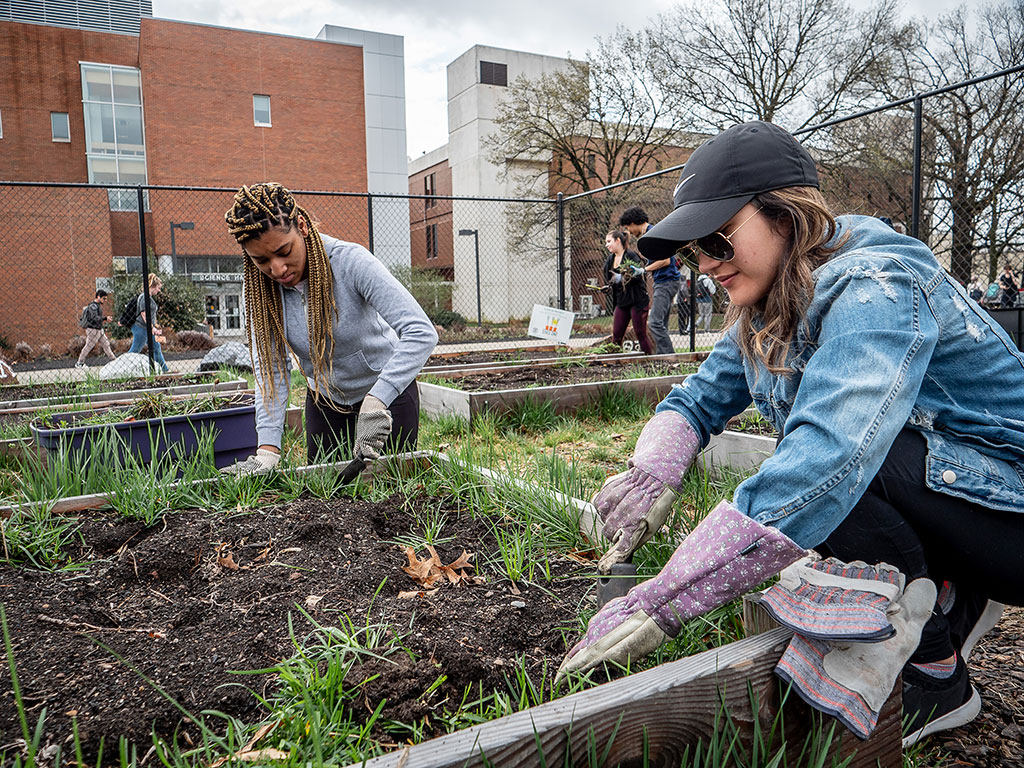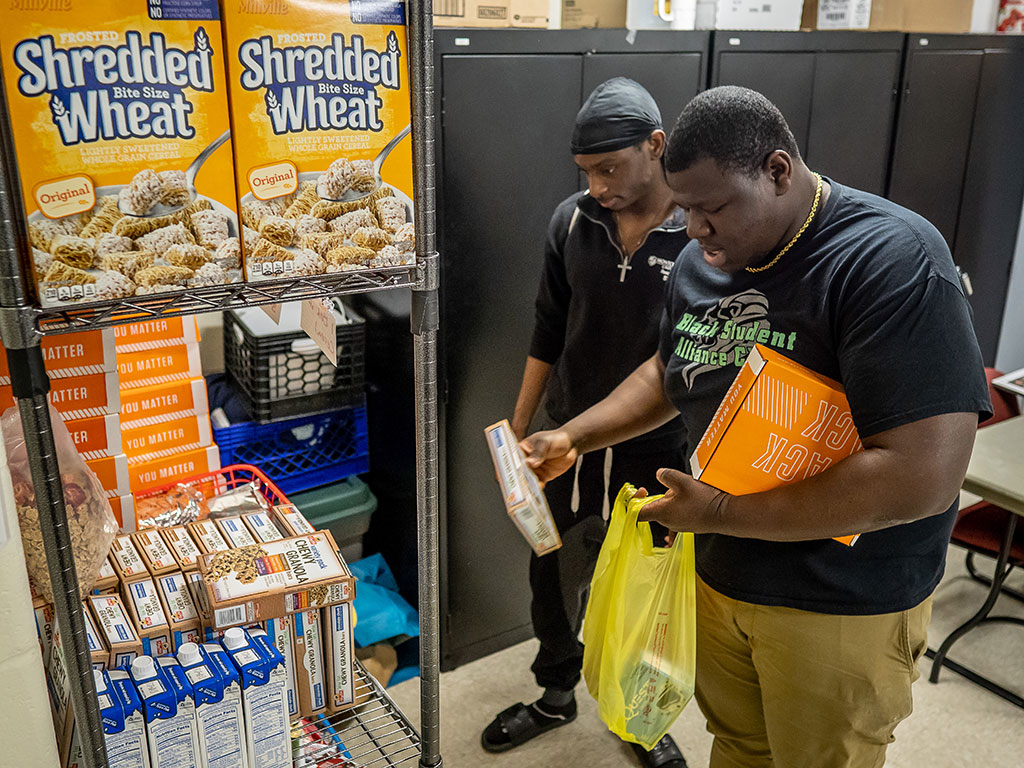
Finding Food Security
Pantry, garden and donations help students stave off hunger
Students prepare the Campus Community Garden for the summer growing season.
By the time Jerry Comprendre Jr. transferred to Montclair State and discovered the Red Hawk Pantry, he was skipping meals and getting a little desperate. “The food pantry saved my life,” he says.
Comprendre, a junior, and his best friend, Jean Pepe, also a junior transfer student, were recently filling bags with groceries – pasta, spaghetti sauce, cereal and almond milk at the pantry.
ShopRite had just made a delivery, so they also had a choice of fresh apples, oranges, spinach and tomatoes.

“Everyone says that to get ahead and make money, you need a college education. But a college education costs money,” says Pepe. “At one point, I considered living in my car to save money,” says Pepe. But after transferring to Montclair State, finding the food pantry and becoming a resident assistant, he has found success. “It’s hard to concentrate when your stomach’s growling. My grades skyrocketed when I became an R.A.”
Montclair State has been a leader in fighting food insecurity since 2016, when it became the first four-year university in New Jersey to open a food pantry on campus. Vice President for Student Development and Campus Life Karen L. Pennington says the University tackled the problem even before fully understanding the extent of it.
“We knew of a few students who were hungry. We knew of a few students who were homeless and we knew that where there’s five, there are 105,” Pennington says. “We decided not to wait for the data. We knew it was happening and decided
to open immediately. That way at least we were helping.”
Indeed, the results of a 2016 survey sent to students confirmed Pennington’s hunch: 37 percent of 200 respondents reported that they experienced food insecurity daily, weekly or monthly, which mirrored national numbers at the time.
Since Montclair State’s pantry opened, it has met a growing need – with nearly 1,000 total visits, according to Sonja Tillman, the coordinator of Student Center Programming and the Red Hawk Pantry. And preliminary results of a 2019 campus survey support the continued need, with four out of 10 respondents reporting some level of food insecurity.
A National Epidemic
Hunger is a reality across college campuses. Students say they forgo food in order to buy books or pay tuition. Others struggle to concentrate in class because of skipped meals or eating smaller meals because they don’t have enough money for food.

A December 2018 report from the Government Accountability Office (GAO), a nonpartisan Congressional agency, notes that millions of low-income students nationwide are potentially at risk of being food insecure and that food-insecure students are at risk for dropping out of school.
When the Red Hawk Pantry opened, there were 300 college food pantries nationwide. Three years later, the College and University Food Bank Alliance reports there are now more than 700. Schools are also fighting food insecurity by redistributing food after catered events, making sure students who are eligible apply for food stamps, and lobbying to change national and state education funding to cover living expenses, not just tuition.
Advocates say that the national epidemic of campus food insecurity is also fueled by a rise in enrollment of low-income and first-generation students.
“Tuition and books and expenses just eat up money and there’s very little left for food for some of our students,” says Tillman. “Many of our full-time students also work and still can’t make it. It’s tough.”
Making a Difference
Since 2016, the University has raised about $47,000 from alumni, students and faculty to help sustain the pantry. “It’s heartbreaking that it’s needed and heartwarming that our community wants to help,” says Stacy Albanese ’08 ’17 MA, associate director of Annual Giving and Alumni Engagement, who conducted the first survey and spearheaded the fundraising campaign. “The pantry remains a priority in all of our fundraising initiatives, including our Annual Giving Day.”
The Red Hawk Pantry is more fortunate than many college pantries in that it is also supported by Lawrence R. Inserra Jr., CEO of Inserra Supermarkets, and his daughter, Lindsey Inserra Hughes, who operate 23 ShopRite stores. The Inserras gave the pantry an industrial refrigerator and freezer and regularly donate perishable items such as produce and dairy products.

“The Inserra family is making a huge difference for our students,” says Tillman. “I have seen students come in here and actually burst into tears because they didn’t know how they were going to eat.”
In addition, last summer, the pantry partnered with the student-tended Campus Community Garden, which donated 300 pounds of fresh produce, including lettuce, tomatoes and cucumbers, to the pantry. This summer, the goal is to donate more and to extend the growing season through October, says Christopher Snyder, a graduate assistant who oversees the garden and conducted the spring 2019 campus food-security survey in which 43.6 percent of students responding reported experiencing some level of food insecurity during the semester.
“Many of our full-time students also work and still can’t make it. It’s tough.”
One thing Snyder, who is working on his master’s in public health, and other food security advocates are seeking is an extension of the kindergarten through 12th grade free or reduced-cost lunch program to cover college students.
“The government gives students free or reduced lunch from K through 12 and then that just stops,” he says. “It’s not like the need for it stops. We need a direct continuation of the school lunch program.”
Beyond helping students, the garden also donates to community pantries and it is a “showcase of sustainability” – part of the PSEG Institute for Sustainability Studies. This year the garden received a grant for a shed and a rainwater harvester.

“It’s a project fueled by passion,” Snyder says. “We’ve turned a brownfield on campus into something that is productive and pleasant to look at.”
In May 2019, New Jersey Governor Phil Murphy signed a “Hunger-Free Campus” Act that will provide grant funding to colleges and universities in New Jersey that are taking an active role in addressing food insecurity, and Pennington says that additional funding will help create solutions beyond the food pantry. The University is working with Dining Services to come up with a stigma-free plan for students to access meals, including using vouchers and Supplemental Nutrition Assistance Program (SNAP) benefits (formerly food stamps).
The majority of the students using the pantry are women, so Tillman also stocks feminine hygiene products and toiletries. Another popular pantry item is laundry detergent – especially the pods, she says.
Easing the Burden
Angelica Vergara, 20, is a third-year commuter student whose baby was four months old when she took him to the food pantry at the end of the spring semester. While she has been using the food pantry since her freshman year, she says, with a baby to care for, she needs it more than ever.
“I’m not working right now because my priorities are my baby and school,” she says. “All of my money goes to diapers and clothes for him, and because I’m nursing, I also need to eat well. I get really hungry.”

Vergara and her baby live in Perth Amboy with her mother, and, even with financial aid, money is tight. Growing up, she was used to getting free or reduced lunch at school, but that stopped when she got to college. “It’s a very hard struggle,” she says.
Because Montclair State is a leader in tackling food insecurity, Soledad O’Brien and her documentary filmmaking team from Starfish Media Group are working on a documentary that includes how the University is addressing it and interviews with students.
“The Montclair students we followed for our documentary are determined and strong and willing to put their education above everything else,” she says. “We hope we can shed some light on the issue and help prompt people to come together to find solutions that make it possible for students to not have to choose between paying tuition and going hungry.”
The end of each semester is the busiest time at the Red Hawk Pantry. Students run out of meal swipes or have difficulty making it to their next paychecks.
The stories Tillman hears from students tug at the heartstrings: “One student broke down in tears and said she was so happy that we carried the kind of cereal her children like,” she recalls. “It’s satisfying because we know we’re making a difference.”